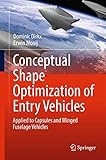Conceptual Shape Optimization of Entry Vehicles [electronic resource] : Applied to Capsules and Winged Fuselage Vehicles / by Dominic Dirkx, Erwin Mooij.
By: Dirkx, Dominic [author.] .
.
Contributor(s): Mooij, Erwin [author.] | SpringerLink (Online service)
| SpringerLink (Online service) .
.
Material type:  BookSeries: Springer Aerospace Technology: Publisher: Cham : Springer International Publishing : Imprint: Springer, 2017Edition: 1st ed. 2017.Description: XVI, 280 p. 178 illus., 130 illus. in color. online resource.Content type: text Media type: computer Carrier type: online resourceISBN: 9783319460550.Subject(s): Aerospace engineering
BookSeries: Springer Aerospace Technology: Publisher: Cham : Springer International Publishing : Imprint: Springer, 2017Edition: 1st ed. 2017.Description: XVI, 280 p. 178 illus., 130 illus. in color. online resource.Content type: text Media type: computer Carrier type: online resourceISBN: 9783319460550.Subject(s): Aerospace engineeringIntroduction -- Mission Heritage -- Flight Mechanics -- Aerothermodynamics -- Numerical Interpolation -- Vehicle Geometry -- Optimization -- Simulator Development -- Results - Capsule -- Results - Winged Vehicle -- Concluding Remarks.
This book covers the parameterization of entry capsules, including Apollo capsules and planetary probes, and winged entry vehicles such as the Space Shuttle and lifting bodies. The aerodynamic modelling is based on a variety of panel methods that take shadowing into account, and it has been validated with flight and wind tunnel data of Apollo and the Space Shuttle. The shape optimization is combined with constrained trajectory analysis, and the multi-objective approach provides the engineer with a Pareto front of optimal shapes. The method detailed in Conceptual Shape Optimization of Entry Vehicles is straightforward, and the output gives the engineer insight in the effect of shape variations on trajectory performance. All applied models and algorithms used are explained in detail, allowing for reconstructing the design tool to the researcher’s requirements. Conceptual Shape Optimization of Entry Vehicles will be of interest to both researchers and graduate students in the field of aerospace engineering, and to practitioners within the aerospace industry.


There are no comments for this item.